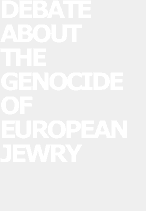| The Debate about the Genocide of European Jewry
In Europe the iconography of the representation of the genocide based itself on documentary material from the very beginning. The images, developed in the hope that they would bear witness to the horror of the camps, were used to create a valid representation of the Shoah. But it remained problematical to have to use these images to depict an ultimately incomprehensible reality. Through the use of masses of photographs, the individual camp internee became one example among many; it was difficult to develop sympathy with that person because the death of a single individual dissolved into the mass murder. The universalization of the pictures, despite the best intentions, has no doubt contributed to their trivialization.
The debate about the genocide of European Jewry has reflected its European dimension from the start, even though in almost all countries the blame was at first projected exclusively on Germany, and their own involvement was only discussed later. However, the realization of the European dimension inevitably led to the understanding that this experience formed a bond between the European nations. The consensus of values, which developed out of this fundament, has thus gained in importance. Since the 1970s the genocide of the Jews has gradually become the paradigm of the 20 th century, the symbol of evil per se.
With their own post-War history under Communist rule the Eastern European states debate this question in a different way. In many of these countries the extermination of the Jews is just one mass murder alongside others these societies have suffered. A differentiated reappraisal of history has just begun.
Memory
Anne Frank
Universalization 
Deconstruction of Stereotypes 
|




